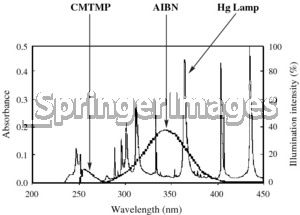A photopolymerization requires a photoinitiator to capture the energy. Where does AIBN absorb versus your source?

OK, that looks good. AIBN has a strong cage effect. 2,2′-Azobis(2-methylpropionitrile) extrudes nitrogen and the radicals combine without initiating polymerization. The dimer, tetramethylsuccinonitrile or 2,3-dicyano-2,3-dimethylbutane, is quite toxic. The superior initiatior is 1,1'-azobis(cyclohexanecarbonitrile), VAZO catalyst 88; J. Org. Chem. 52 2958 (1987) (e.g., Sigma-Aldrich Chemical Company).
Camphorquinone (yellow powder) can replace AIBN, shifting absorption into the visible, 380 - 510 nm. That is a tungsten-halogen bulb or a middling blue LED, GaN or InGaN maxing at 450 - 460 nm. The graph's yellow line is camphorquinone.

Molecular oxygen quenches free radical polymerizations. If things stay gooey, add a little more initiator to the starting mix to burn out the oxygen. Now, the fun part! If you treat the clean glass slides with Rain-X, (spray, wait a few minutes, wipe, lightly buff; maybe lock in at 110 C for 15 minutes) you silanize the surface and polymer will not stick. It's a miracle for treating vacuum polymerization ampoules. If you want a cleaner surface and can play chemist,
http://www.gelest.com/gelest/forms/GeneralPages/Applications/hydrophobic_materials.aspx
Gelest Aquaphobe CM, diluted by you to 8% in dichloromethane or toluene as a 5-minute soak in a closed glass container. Soak, rinse with solvent, lightly buff, oven. The active material gives off HCl, including exposure to humidity.


